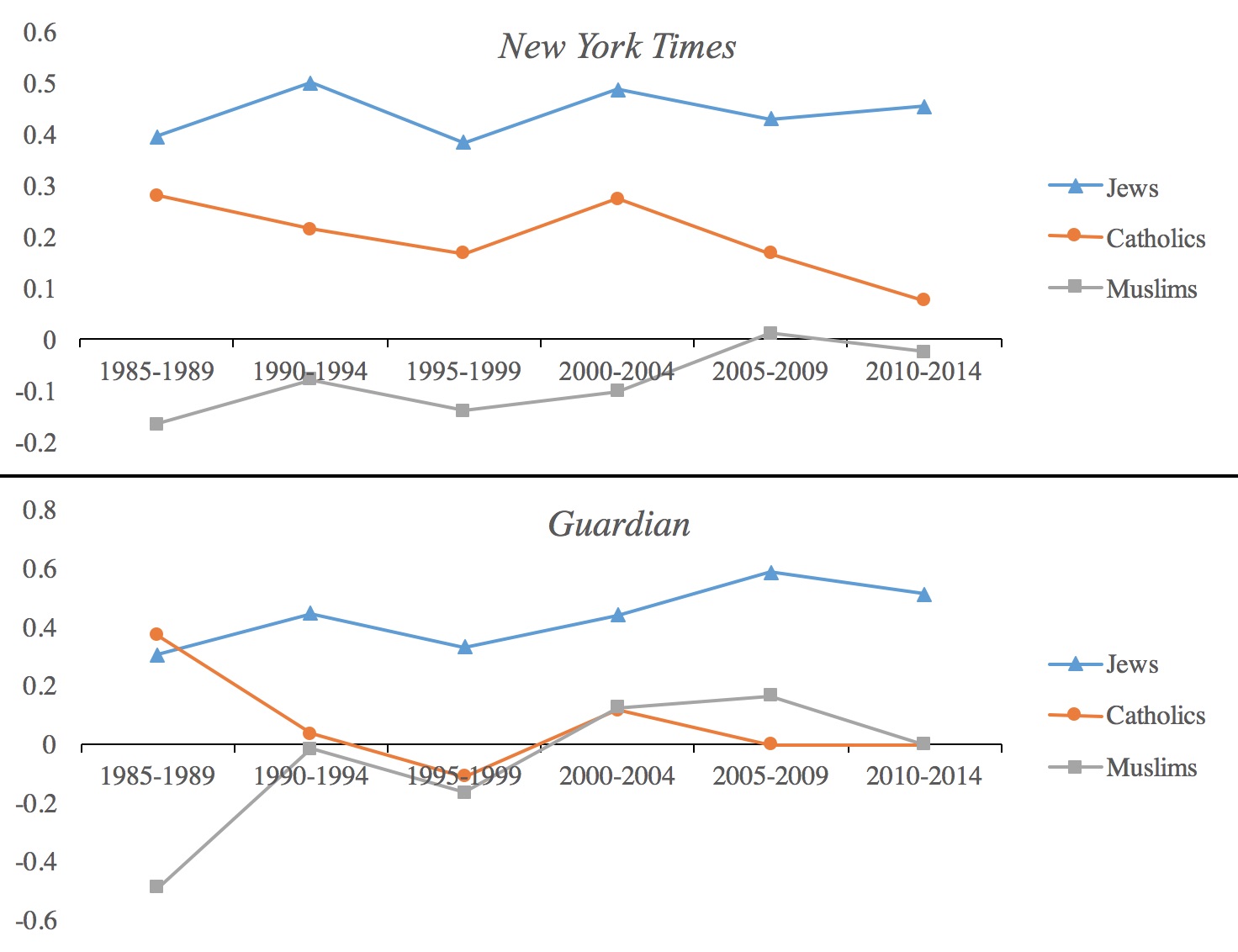Headlines about Muslims, Jews, and Catholics
Portrayals in The New York Times and The Guardian, 1985-2014

How do major newspapers portray Muslims in comparison to Jews or Catholics? Most scholars find that the media reinforce negative messages about Muslims. But what if all religious groups are depicted in a negative light? We analyzed the tone of over 2,000 headlines about Muslims, Jews, and Catholics from The New York Times and The Guardian to explore how the media cover these groups. This generates two key insights.
First, in aggregate, headlines about Muslims are more negative than those about Jews or Catholics. We use a measure of the “net tone” of articles about a group that subtracts the number of negative headlines from the number of positive headlines, then divides that by the total number of headlines (including headlines with no clear tone). Examining all headlines from both newspapers shows that the overall net tone of headlines about Jews is +0.44, whereas the net tone for Catholic headlines is +0.14, and it is -0.03 for Muslims. These are statistically significant differences.
On average, therefore, although headlines about Muslims are not as negative some may expect, they are consistently more negative than those about other groups. This is especially true when comparing how Muslims and Jews are covered.
Why are headlines about Jews so positive? A large number of headlines evoke sympathy for Jews through coverage of anti-Semitic attacks, or remind readers of Jewish victimization in the Holocaust. Headlines such as “Venezuela: Attack on Jewish Center” or “Jews Honour Holocaust Victims” constitute between 35% and 58% of all headlines about Jews in The New York Times and The Guardian, respectively. In addition, headlines about Jewish art and culture such as “Book Awards Given for Jewish Themes” comprise another quarter of all headlines in both newspapers. There are also exceptionally few unambiguously negative headlines about Jews in either newspaper. In total, only 32 out of 673 headlines about Jews had a distinctly negative tone.
By contrast, 313 of the 1003 headlines about Muslims were negative. Unsurprisingly, Islamic extremism and Muslim violence were common themes. At the same time, these negative headlines were offset to some degree by 280 positive headlines. Islamic art and culture were common topics, with headlines like “Decorative Themes in Islamic Architecture” or “Muslim Family to Appear in Coronation Street for First Time.” Positive headlines also evoked sympathy for Muslims as the targets of Islamophobia, and even identified Muslims as opposing terrorism and extremism, through headlines like, “Muslims Flock to ‘Anti-Terror’ Summer Camp: Hundreds Attend Three-Day Event to Learn how to Fight Arguments of Extremists.”
A second central insight from our research is that newspapers can differ in important ways. While headlines about Jews were highly positive in both outlets, the relationship between Catholic and Muslim headlines diverged significantly.
In The New York Times, headlines about Catholics were consistently more positive than those about Muslims. The overall net tone of headlines about Catholics was +0.21, while the net tone of Muslims headlines was -0.07.
However, headlines about these two groups in The Guardian were statistically indistinguishable. Across all time periods, the net tone of Catholic headlines was +0.06 while that of Muslims was 0. Looking at the five year intervals identified in the above image shows that the net tone has been almost exactly the same in The Guardian since 1990.
In part, the relative positivity associated with headlines about Muslims in The Guardian involves the increasing presence of stories about British Muslims, as opposed to coverage of foreign Muslims. Beginning in the 2000–2004 period, headlines about British Muslims accounted for over 36% of positive headlines but less than 4% of negative headlines. Positive headlines included “Muslim Britain: Culture of Charity” and “The Reaction to the Woolwich Murder Denies British Muslims a Political Voice.”
While Guardian headlines about Muslims become more positive after the 1985–1989 period, headlines about Catholics become more negative. This downward shift is explained by a notable rise in negative headlines. These headlines were primarily about Church pedophilia scandals and Catholic stances on contemporary social issues. Specifically, Church scandals account for 30% of the total negative headlines from 1990 to 2014, with headlines such as “Catholic Bishops ‘Knew of 20 Sex Abuse Allegations by Priests’.” Catholic views on social issues like same-sex marriage, abortion, and contraceptives constitute 28% of negative headlines. These include headlines like “Scots Cardinal Attacks Abortion ‘Massacres’: Catholic Leader Demands NHS Block on Terminations” and “Christmas Messages: Archbishop Attacks Cameron’s Plans for Same-Sex Marriage… Catholic Cleric’s Comments Rejected by Gay Groups.”
On the whole, headlines about Muslims are likely to be neutral rather than negative, but more negative than headlines about Catholics, and especially than headlines about Jews. However, the example of The Guardian after 1990 suggests that as Muslims become a larger demographic presence in Western societies, coverage in “domestic” settings may lead to an increasing proportion of positive headlines. Muslims may not be a group like any other, but they are not necessarily destined to be portrayed in a relentlessly negative fashion.
-Erik Bleich
Methodological note: We coded 2,027 headlines containing the root words Muslim/Moslem, Islam, Jew/Judai, and Catholic, drawing a systematic sample from The New York Times and The Guardian during the 30 years between January 1, 1985 and December 31, 2014. Each headline was coded positive, negative, or no tone. More information on our methods and results can be found in “Investigating Status Hierarchies with Media Analysis: Muslims, Jews, and Catholics in The New York Times and The Guardian Headlines, 1985-2014,” Erik Bleich, Hasher Nisar, and Cara Vazquez, International Journal of Comparative Sociology, 2018